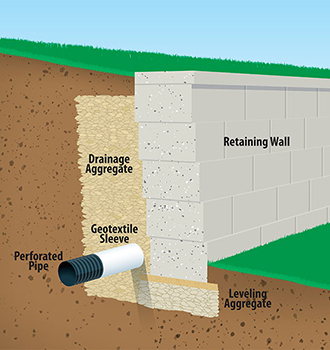Retaining walls with a height greater than a few feet should also have weep holes that are regularly spaced in the vertical direction forming a grid pattern.
Perforated drain pipe behind retaining wall.
Another method for relieving hydrostatic pressure is to install a drainage pipe behind the wall.
Not adding drainage pipes.
No stones behind the wall.
Any reinforced wall or walls over 4 ft.
The toe drain and the wall rock is designed to remove incidental water from behind the wall and is.
Steven baczek a residential architect from reading mass who specializes in designing durable low energy homes responds.
Mar 19 2014 when building a retaining wall lay perforated drainage tubing at the base of the wall slightly above ground level so runoff can drain out without undermining your wall.
These will allow water to drain out of the earth and prevent your soil from getting waterlogged and excessively heavy.
Backfilling the space behind the blocks with crushed stone and then installing a flexible perforated drainpipe available at the home depot also called drain tile at the base of the wall.
I hear arguments for both methods but it really depends on how the pipe functions in your drainage system before going any further the pipe we are discussing here is heavy duty.
This drainage column allows water to migrate downward to the base of the wall.
In all cases wall rock is located within the cores of the block and a minimum of 12 in.
Some of these drains are vented through the front of the retaining wall while others may run the length of the wall and drain out to the sides.
When i use perforated pipe in a drainage system should the holes go up or down.
This helps create a hollow channel for water to go in the event of a heavy rain or watering.
1 2 m in height or with slopes or other surcharges above the wall will need a toe drain.
Pipe drains also known as toe drains are perforated pipes that collect water along the length of the wall and drain it to the outside.
Once the water makes it to the base of the wall it enters the perforated drain pipe.
This should be a perforated pipe to allow water to enter it through the length of the wall.
In addition to the foot of backfill that is used behind your retaining wall you should also make sure that perforated piping is laid at the bottom of the backfilled portion of the wall.
Pipe drains are usually installed at the base of the wall but.




























